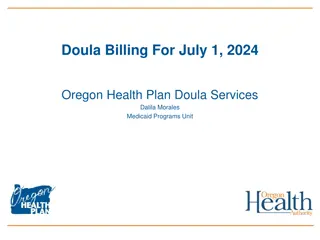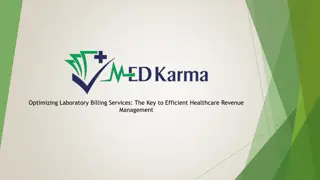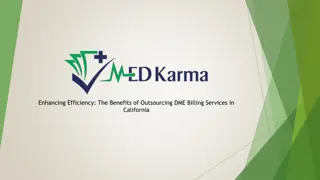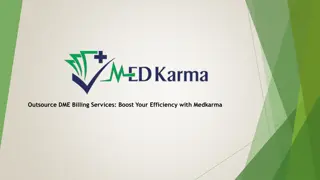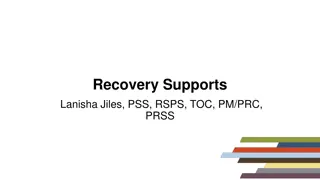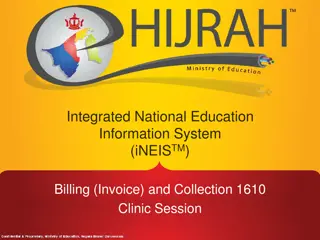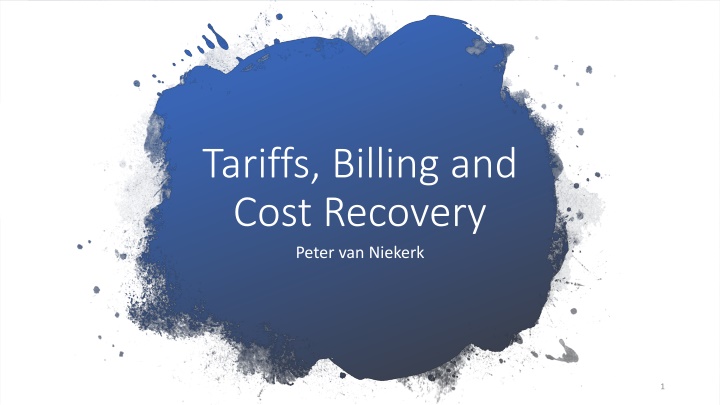
Water Tariffs, Billing, and Cost Recovery Strategies
Explore the importance of tariffs in water resource management, cost recovery principles, funding mechanisms, and pricing strategies for sustainable water use and management. Learn about the objectives of raw water pricing strategies and their role in promoting sustainability, social equity, ecological efficiency, and economic viability.
Download Presentation

Please find below an Image/Link to download the presentation.
The content on the website is provided AS IS for your information and personal use only. It may not be sold, licensed, or shared on other websites without obtaining consent from the author. If you encounter any issues during the download, it is possible that the publisher has removed the file from their server.
You are allowed to download the files provided on this website for personal or commercial use, subject to the condition that they are used lawfully. All files are the property of their respective owners.
The content on the website is provided AS IS for your information and personal use only. It may not be sold, licensed, or shared on other websites without obtaining consent from the author.
E N D
Presentation Transcript
Tariffs, Billing and Cost Recovery Peter van Niekerk 1
Why Tariffs? Sustainability User-must-pay principle Capital, and interest on capital, must be recovered Operation and management costs must be recovered Costs directly related to water projects Costs generally related to water resource management Resource use must be economically efficient Correct pricing communicates the scarcity value of a resource and contributes to its efficient use. PRICING STRATEGY 2007: Revision in offing but currently still valid 2
Funding of Water Resource Development and Use of Waterworks Tariffs (called charges in the Strategy) for return on assets and operation and maintenance of capital works (Government Water Schemes) are ring-fenced in the, so-called, Water Trading Entity The funds in the WTE are to be employed in defraying costs related to these works and certain expenditures towards future such works. 3
Funding of Water Resource Management (WRM) Intended to fund WRM activities by DWS and/or CMAs Charges for abstraction Charges for waste discharges 4
For more detail on the Pricing Strategy see following presentation compiled by Willie Enright 5
Pricing Strategy For Raw Water Willie Enright
Raw Water Pricing Strategy 2005 Policy framework laid down in Chapter 5 of National Water Act, 1998 (NWA) Legislative mandate: Sections 56 - 60 of the NWA Raw Water Pricing Strategy (RWPS) first established in November 1999. The first revision of the pricing strategy published on 1 July 2005.
Objectives of the Pricing Strategy Raw Water Pricing Strategy Sustainability Sustainability Social Equity Ecological Efficiency Economic Financial
Objectives that shape new Pricing Strategy Social equity Redressing imbalances Provision of subsidies, direct access Ecological sustainability Reserve (quantity and quality), WC/DM Management of catchment, Financial sustainability Inflation, refurbishment, asset replacement Economic efficiency Price of resource be set to reflect scarcity Incentive to conserve water / opportunity cost Polluter pays
Pricing Strategy Catchment management charges: Water is free Charges are for management and control of use You pay for the service rendered Differentiate in use Assurance of supply to be taken in account
Pricing Strategy The pricing strategy contain a strategy for setting water use charges - (a) For funding water resource management; (b) For funding water resource development and use of waterworks; (c) For achieving the equitable and efficient allocation of water.
Social Equity Redressing the imbalances of the past with respect to: - Inequitable access to basic water services at affordable tariffs within municipal areas, by facilitating a conditional subsidy on raw water cost where stepped tariffs are introduced - Inequitable access to water for productive use purposes by subsidising tariffs for emerging farmers for a limited time period.
Ecological Sustainability Pricing will take account of the cost of: - Safeguarding the ecological reserve - The ecological management of the catchment - Water quality protection - Water conservation and demand management
Financial Sustainability Generating adequate revenue for funding the annual cost related to: -the management of water resources -the operation and maintenance of existing schemes -the rehabilitation of existing schemes - the development of augmentation schemes In the process of annual tariff increases to reach this objective, the constraints within various user sectors to adapt to price increases will be taken into account
Economic Efficiency To promote the efficient allocation and beneficial use of water, water should be priced at its opportunity cost. The Pricing Strategy provides for administrative as well as market-related measures to achieve this goal.
Contents of Pricing Strategy Minister concurred with Minister of Finance to establish a pricing strategy for water use: 56(1): for funding water resource management regulate, manage and maintain water resource/catchment for funding water resource development and use of waterworks Planning, design, development, O&M and improvement Capital costs - Depreciation, Return on Assets Pre-financing, assurance of supply for achieving the equitable and efficient allocation of water use
Contents of Pricing Strategy Types of raw water charges in pricing strategy: Funding water resource management by water management institutions (WMI) Funding of the development and use of waterworks Charging an Economic Charge Charging a waste discharge charge/levy Charging a Water Research Levy
Implications of pricing strategy on CMAs Water use charge are only applied to and collected from registered water users Where water in the WMA is fully utilised or over allocated (registered use exceeds allocable water) the volume of registered sectoral water use will determine charges CMA must annually budget for the estimated costs of activities to be performed in the WMA Water resource management activity costs must be allocated to sectors in proportion to average annual sectoral use
Catchment management charges to defray costs Functional support (Management) Planning and implementation of catchment management functions Dam safety control Water quality management Pollution control Water utilisation Water allocation Water use control Water conservation Eradication of invasive plants Demand management
Budgeting for activity costs for WRM Charges Costs of WRM activities in WMA Registered volumes/waste load in WMA Unit Cost Costs of WRM activities will be divided between abstraction and waste related activities
Water Uses subject to pricing (1/11) Water use includes (Chapter 4):- (a) taking water from a water resource (b) storing water (c) impeding or diverting the flow of water in a water course (d) engaging in a stream flow reduction activity (e) engaging in a controlled activity (f) discharging waste or water containing waste into a water resource through a pipe, canal, sea outfall (g) disposing of waste in a manner which may detrimentally impact on a water resource.
Water Uses subject to pricing (2/11) Water use includes - (continued) (h) disposing of water which contains waste from, or which has been heated in, any industrial or power generation process (i) altering the bed, banks, course or characteristics of a watercourse (j) removing, discharging or disposing of water found underground if necessary for the efficient continuation of an activity or for the safety of people (k) using water for recreational purposes
Allowable water uses not subject to pricing Permissible use in terms of Schedule 1 of the NWA The reserve related to basic human needs The ecological reserve Water required to meet South Africa s commitments regarding international waters obligations.
Allowable water uses not subject to pricing Schedule 1 to the NWA, can take place without licence or registration:- Reasonable domestic use (lawful access) Small gardening (not commercial purposes) Watering of animals (excluding feedlots) Store and use of run-off water from a roof Emergency situations (firefighting) Recreational purposes (lawful access) Discharge of waste in system controlled by another person
CMA can set Sectoral Charges Sectoral charges must be determined annually for the following sectors: Water service authorities (municipal) Industrial, mining, energy and evaporation ponds Irrigation Stream flow reduction activities - afforestation
Costs must be allocated to sectors in proportion to volumetric average annual sectoral use Registered sectoral water use will take into account the assurance of supply from State and WUA schemes The Pricing Strategy determines that the following activity costs must not be allocated to the Forestry sector * Dam safety control * WFW - control of invasive plants
Setting of Sectoral Charges Unit costs per sector will be determined for each WMA by dividing budgeted activity costs by the allocatable sectoral use Unit charges in cents per m3 for pricing purposes will take account of subsidies granted i.r.o the Pricing Strategy The WFW unit cost for irrigation is subsidised by 90%
Registered User Sectors Domestic/Industrial/Mining/Energy Water allocations as reflected on a lawful permit, general authorization or license and and/or verified as existing lawful use and amended for assurance of supply. Irrigation The SAPWAT programme developed by the Water Research Commission or other method approved by DWAF to determine average annual irrigation use. SFRA (Forestry) Modified tables based on the WRC Report No. TT 173/02 (April 2002): Estimation of stream flow reductions resulting from commercial afforestation in South Africa.
Budgeting for activity costs for WRM Charges Costs of Abstraction related activities in WMA Registered volumes in WMA Unit Cost
Water Resource Management Activities Monitoring & assessing water resource availability and use Planning & implementation of CMSs Water use allocations Water Resource Management Activities in WMAs Institutional development & public partici- pation Management of floods, droughts, water abstraction, Etc. Water Management of water quality water & resource protection conservation & demand management
Inter-Basin Transfers For inter-basin transfers, the loss of income to the donor CMA will be funded by water use charges raised in the receiver WMA
Budgeting for activity costs for Waste Related Water Resource Management Charges Costs of Waste related WRM activities in WMA Registered waste load in WMA Unit Cost
Waste Discharge Charge System The waste discharge charge system comprise of two distinct water use charges which may be applied in a specific catchment. These are:- Charge to cover the quantifiable cost of administratively implemented measures for the mitigation of waste discharge related impacts (mitigation charges). Charge that provides a disincentive or a deterrent to the discharge of waste (incentive charge).
Water Resource Management charges for waste discharge Waste Discharge WRM activities will be charged to municipal (domestic), industrial, mining, energy and agricultural sectors. Charges will be calculated on registered discharge waste load of salinity and phosphorus Salt load will be estimated using electrical conductivity. Phosphorus will be estimated using soluble phosphorus.
Waste Discharge Charge System The waste discharge charge system comprise of two distinct water use charges which may be applied in a specific catchment. These are:- Charge to cover the quantifiable cost of administratively implemented measures for the mitigation of waste discharge related impacts (mitigation charges). Charge that provides a disincentive or a deterrent to the discharge of waste Economically efficient tool to reduce loads at source(incentive charge).
Waste Discharge Cost Allocation Abstraction related costs Total WRM cost in WMA Waste discharge related costs Point source Marine Outfalls Waste disposal Irrigated effluent Salt cost Salt cost Salt cost Salt cost Phosphate cost Phosphate cost Phosphate cost Phosphate cost Example: WRM Waste Charge on salt load as point source Allocated cost for salt load management Total registered waste load of salt
Year 2008/09 2009/10 2010/11 Staff costs Board R760 000 R760 000 R760 000 CEO Office R950 000 R950 000 R950 000 Institutions & Participation R1 900 000 R2 450 000 R2 450 000 WR Planning & Programmes R750 000 R1 600 000 R1 600 000 Water Use Management - R3 150 000 R3 150 000 Governance R450 000 R450 000 R450 000 Corporate & Finance R850 000 R1 350 000 R1 350 000 Total (full) R5 460 000 0 510 000 R10 510 000 Total (projected)* R2 760 000 R8 460 000 R10 510 000 Overheads R1 000 000 R3 000 000 R3 000 000 Set-up R1 000 000 - - Outsourcing Organisational development R500 000 R500 000 - Institutional development R500 000 R500 000 R250 000 CMS development R500 000 R1 500 000 R500 000 Financial & Corporate R500 000 R500 000 R500 000 Total R2 000 000 R3 000 000 R1 250 000 Capital Repayments - ? ? TOTAL CMA R6 760 000 R14 460 000 R14 760 000
Water Resource Management Charge WRM activity Quantity X 106 Water transfer out 23% WRM activity Dam Safety WFW Total Costs Plus Inter WMA Transfer Input Costs* Less WFW Subsidies Revenue Sectoral Charge WFW Charge Sectoral Charge less WFW Charge Rx1000 Rx1000 Industrial 1013,06 1013 77% 76,9 927,6 8,5 14 460 28 4 578 19 066 11 134 22 3 525 14681 1,10 0,00 0,35 1,10 0,00 Nil 0,35 Nil 0,70 3543 Nil 2071 0,32 Nil 1,14 0,04 1,10 1,45 0,35 1,10 0,70 0,00 0,70 Final Charge for 2004/2005 Final Charge for 2005/2006 Final Charge for 2006/2007 Final Charge for 2007/2008 Proposed Charge for 2008/2009 Proposed Charge for 2009/2010 2.64 2.64 2.64 2.75 2.93 0.64 0.64 0.64 0.67 0.71 0.41 0.26 0.25 0.26 0.28 2,93 1,14 0,7
Phasing in of consumptive charges Domestic/Industrial/Mining/Energy sector Annual increases will be limited to 10% + PPI (rate taken in June) until full cost recovery is reached Charges will not be reduced below previous year s level Price production Index (PPI) for April 2007 = 6,4%

